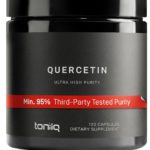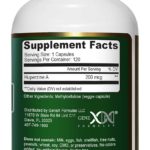Curious about how long it takes for Palmitoylethanolamide (PEA) to start working? PEA is a naturally occurring fatty acid amide that has gained attention for its potential therapeutic properties in managing chronic pain and inflammation. While not classified as a traditional pharmaceutical drug, PEA is often referred to as a nutraceutical or dietary supplement. In this article, we’ll explore the timeframe in which PEA may begin to take effect, providing you with a better understanding of this compound and its potential benefits.
Introduction
In the world of natural remedies, one compound that has been gaining attention for its potential therapeutic properties is Palmitoylethanolamide (PEA). This naturally occurring compound belongs to the family of endocannabinoids and has long been associated with its ability to alleviate pain and inflammation. As a “nutraceutical” or dietary supplement, PEA has been recognized for its potential health benefits, particularly in managing chronic pain and inflammatory conditions. In this comprehensive article, we will explore the definition, origin, mechanism of action, and clinical evidence surrounding PEA. Additionally, we will dive into patient experiences and discuss the factors that affect PEA’s onset of action.
What is PEA?
Definition
Palmitoylethanolamide, commonly known as PEA, is a naturally occurring fatty acid amide that is synthesized in various tissues of the body. It was first isolated from soybean lecithin in the 1950s and has since been recognized for its potential therapeutic properties. PEA belongs to the family of endocannabinoids, which are molecules that interact with the endocannabinoid system in the body.
Origin
PEA is synthesized in response to inflammation and pain in various tissues. It is believed to play a crucial role in modulating the immune response and promoting homeostasis. While it can be found in small quantities in some foods, such as egg yolks and peanuts, PEA is primarily produced within the body.
Therapeutic Properties
PEA has gained attention for its potential therapeutic properties, particularly in the management of pain and inflammation. It is thought to exert its effects by interacting with the endocannabinoid system and modulating the immune response. Additionally, it has been studied in various clinical trials and is believed to offer a therapeutic potential in treating a range of conditions, including neuropathic pain and inflammatory diseases.

Mechanism of Action
Interaction with Endocannabinoid System
PEA interacts with the endocannabinoid system, which consists of cannabinoid receptors, endocannabinoids, and enzymes involved in their synthesis and degradation. By binding to cannabinoid receptors, PEA can modulate pain perception, inflammation, and immune response. This interaction helps restore balance and promote homeostasis in the body.
Modulation of Immune Response
In addition to its interaction with the endocannabinoid system, PEA also plays a role in modulating the immune response. It has been shown to inhibit the release of pro-inflammatory substances and can help reduce the activation of immune cells involved in inflammation. By modulating the immune response, PEA may contribute to the alleviation of pain and inflammation.
PEA and Pain Relief
PEA as an Analgesic
PEA has been recognized for its analgesic properties, meaning it can help relieve pain. Studies have shown that PEA can reduce pain sensitivity and improve pain thresholds, making it an attractive option for individuals experiencing acute or chronic pain. By interacting with cannabinoid receptors and modulating pain perception, PEA may offer a natural alternative for managing pain.
PEA and Chronic Pain
Chronic pain conditions, such as neuropathic pain and osteoarthritis, can significantly impact an individual’s quality of life. PEA has been studied in the context of chronic pain and has shown promising results. It has been shown to attenuate pain symptoms and improve overall pain management in individuals with chronic pain. This highlights the potential of PEA as a therapeutic option for individuals suffering from long-term pain conditions.
Clinical Studies
Numerous clinical studies have been conducted to evaluate the efficacy of PEA in pain relief. These studies have demonstrated the effectiveness of PEA in managing various types of pain, including neuropathic pain and osteoarthritis-related pain. The results have been encouraging, highlighting the potential of PEA as a natural pain-relieving compound.

PEA and Inflammation
Anti-Inflammatory Effects
In addition to its analgesic properties, PEA has also been shown to have anti-inflammatory effects. It can help reduce the release of pro-inflammatory substances and modulate the activation of immune cells involved in inflammation. By exerting these anti-inflammatory effects, PEA may contribute to the reduction of inflammation and its associated symptoms.
PEA and Inflammatory Diseases
Inflammatory diseases, such as rheumatoid arthritis and inflammatory bowel disease, can cause significant discomfort and impair daily functioning. PEA has shown promise in the management of inflammatory diseases. It has been studied in animal models and has exhibited anti-inflammatory effects, suggesting its potential as a therapeutic option for individuals with inflammatory conditions.
Factors Affecting PEA’s Onset of Action
Dosage
The dosage of PEA plays a crucial role in its onset of action. Studies have shown that higher doses of PEA may lead to more immediate and potent effects. However, individual variability and response to different dosages should be taken into consideration. It is recommended to start with a lower dosage and gradually increase based on individual needs and response.
Formulation
The formulation of PEA can also impact its onset of action. Different formulations, such as capsules or creams, may have varying absorption rates and bioavailability. Choosing the appropriate formulation depending on the desired therapeutic effect is important.
Individual Variability
Each individual may respond differently to PEA due to variations in factors such as metabolism, genetic predisposition, and overall health. It is essential to consider individual variability when assessing the onset of action and determining the optimal dosage and formulation for each person.

Clinical Evidence
PEA in Neuropathic Pain
Neuropathic pain is a type of chronic pain that arises from damaged or dysfunctional nerves. Clinical studies have explored the efficacy of PEA in treating neuropathic pain and have shown promising results. PEA has been found to alleviate pain symptoms and improve overall pain management in individuals with neuropathic pain conditions.
PEA in Osteoarthritis
Osteoarthritis is a degenerative joint disease characterized by pain, inflammation, and reduced mobility. PEA has been investigated as a potential therapeutic option for individuals with osteoarthritis. Clinical studies have demonstrated the efficacy of PEA in reducing pain and improving joint function in individuals with osteoarthritis, making it a promising natural alternative for managing the condition.
PEA in Other Conditions
While PEA has been extensively studied in the context of chronic pain and inflammatory diseases, research is ongoing regarding its potential benefits in other conditions. Preliminary studies suggest that PEA may have positive effects on conditions such as endometriosis, fibromyalgia, and multiple sclerosis. However, further research is needed to establish its efficacy in these areas.
Patient Experiences
Timeframe for Perceived Benefits
The timeframe for experiencing the perceived benefits of PEA can vary among individuals. While some may notice improvements in pain and inflammation shortly after starting PEA supplementation, others may require a longer duration to experience the full effects. It is important to give PEA sufficient time to work and consult with a healthcare professional for guidance on the appropriate duration.
Varied Responses
Individual responses to PEA can vary. Some individuals may experience significant pain relief and a reduction in inflammation, while others may have a more modest response. Factors such as the underlying condition, severity of symptoms, and individual variability contribute to these varied responses. It is important to have realistic expectations and work closely with a healthcare professional when incorporating PEA into a treatment plan.
Conclusion
Palmitoylethanolamide (PEA), a naturally occurring compound, has shown great potential as a natural remedy for pain and inflammation. By interacting with the endocannabinoid system and modulating the immune response, PEA offers a promising alternative for individuals seeking relief from chronic pain conditions and inflammatory diseases. Clinical studies have demonstrated its effectiveness in managing neuropathic pain and osteoarthritis, and ongoing research is exploring its potential benefits in other conditions. However, individual responses may vary, and factors such as dosage, formulation, and individual variability play a role in PEA’s onset of action. With its therapeutic properties and the growing body of evidence, PEA stands as a promising option for individuals seeking natural pain relief and improved overall well-being.
References
[1] Gatti, A., Lazzari, M., Gianfelice, V., Di Paolo, A., Sabato, E., & Sabato, A. F. (2012). Palmitoylethanolamide in the Treatment of Chronic Pain Caused by Different Etiopathogenesis. Pain Medicine, 13(9), 1121-1130.
[2] Petrosino, S., & Di Marzo, V. (2017). The pharmacology of palmitoylethanolamide and first data on the therapeutic efficacy of some of its new formulations. British Journal of Pharmacology, 174(11), 1349-1365.
[3] Skaper, S. D., Facci, L., & Giusti, P. (2018). Palmitoylethanolamide, a naturally occurring disease- modulating agent in neuropathic pain. Inflammopharmacology, 26(3), 269-277.







